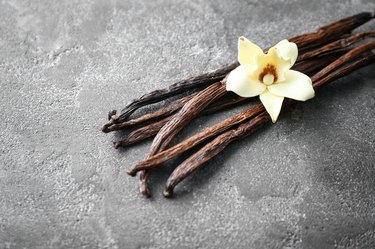
Of all the heady aromas that waft from your oven, nothing compares to cookies, cakes and other pastries baking. Chances are, no matter what you're baking, it's the scent of vanilla — at once sweet, buttery and spicy — that lures people in. From planting to curing, vanilla is such a labor of love that it's no wonder its extract is pricey. If you're fortunate enough to possess a bottle, follow the guidelines for proper vanilla extract storage and it will serve you well for years to come.
Pollinating by Unique Mexican Bee
Video of the Day
Most vanilla extract comes from vanilla beans grown in Madagascar, Indonesia, Mexico or Tahiti. Although the vanilla vine originated in Mexico, today's Madagascar Bourbon Islands grow the most vanilla and supply most of the world's extract. Madagascar Bourbon vanilla extract is named for the area where the beans are grown, not because it's made with bourbon whiskey. (It isn't.)
Video of the Day
The vanilla plant is an orchid and the only orchid with edible fruit. It grew wild in Mexico and flourished because the orchids were pollinated by the Mexican bee, the Melipona. When vines were taken to the Bourbon Islands, however, they grew and produced beautiful flowers but rarely any vanilla pods. No other insects are able to reliably pollinate the vanilla orchid.
Pollinating by Hand
Eventually, scientists figured out how to pollinate the orchid by hand, which is still done by vanilla farmers today. There's just one problem with that. The vanilla plant only flowers one day out of the whole year. If the pollinating farmers miss it, that plant won't produce any vanilla bean pods. Zilch.
Sweating and Baking in Sunshine
The pods are picked when they're still green and the tip is starting to turn yellow. Each country uses a slightly different curing process, but all involve setting the beans out in the sun each day for at least a month or longer. The beans are placed in boxes to sweat at night and then put out in the sun again in the morning to bake all day. The entire process takes between three and six months.
Each country's soil, growing conditions and curing process differ, resulting in different-tasting vanilla beans and extracts. In Indonesia, the beans are picked all at once whether they're ripe or not. Then they're treated with kerosene heat to speed up the curing. Cheaper vanilla extract that's still the real thing usually comes from this Indonesian process.
Making Imitation Extract with Chemicals
The long, intensive process of curing the vanilla beans and the need for human labor throughout is what makes vanilla extract expensive to purchase. So, manufacturers make imitation vanilla extract that sells for a fraction of the cost of pure vanilla extract. Imitation extract contains no actual vanilla; it's made entirely of chemicals designed to imitate the taste of the real thing.
Ensuring Proper Vanilla Extract Storage
To maintain its freshness and taste, tighten the cap and store it in a cool, dry place such as a kitchen cupboard. Avoid storing it in cupboards that may become too hot, like those above the stove or heat vents. You may wonder if vanilla extract needs to be refrigerated after opening it. Not only does it not need refrigeration, but vanilla extract should never be refrigerated, even after opening it. Refrigerated air is too cold for the extract, and it will become cloudy. These same guidelines apply to both pure and imitation vanilla extracts.
Using Other Forms of Vanilla
While most recipes call for vanilla extract, you can use vanilla in other forms instead of or in addition to the extract. It's available as vanilla paste, vanilla powder and whole vanilla beans. Vanilla beans and seeds are strong and flavorful. To access the seeds, cut through the pod lengthwise, open it up and scrape out the seeds with a knife. Vanilla bean paste storage and powder as well is the same as the guidelines for extract. Vanilla beans should be kept in a tightly closed bottle or plastic bag to stay moist and should keep about two years.
Substitute any of these alternatives:
- 1 teaspoon vanilla extract = 1 teaspoon vanilla paste = 1 teaspoon vanilla powder
- 1 tablespoon vanilla paste = 1 vanilla bean
- Vanilla sugar = sugar infused with vanilla extract = substitute 1:1 for granulated sugar
Storing Extract in Dark Bottles
Vanilla extract, like other extracts, keeps best in glass bottles that are dark. This keeps light from getting to the precious substance and altering its taste. When stored in its original brown bottle, vanilla extract will keep indefinitely.